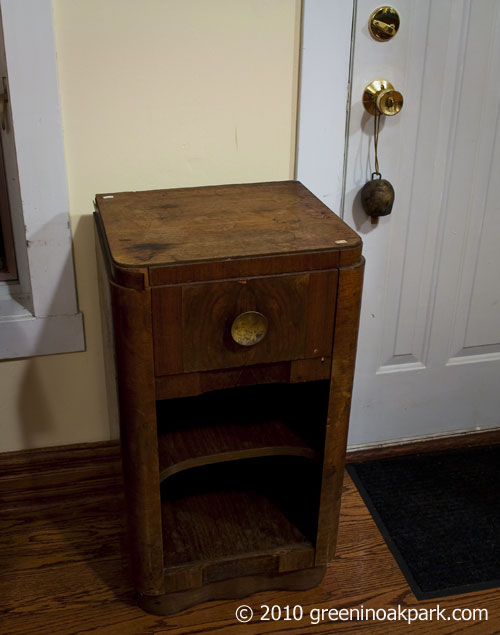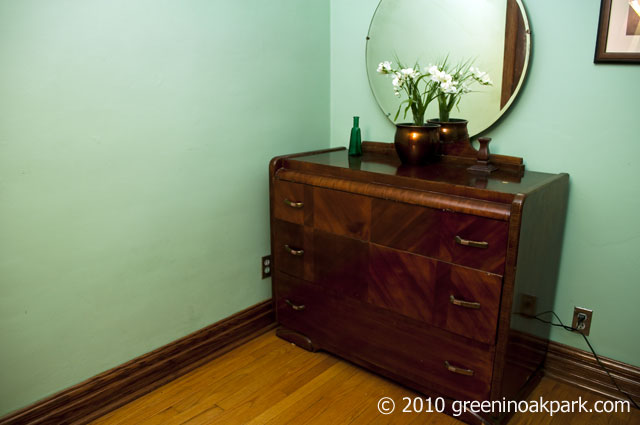Let’s face it- re-using isn’t always easy or trendy, but it is green. And re-using can include furniture and the finishing touches of the rooms in our houses as well.
Our house was built in 1925, and rather than swimming against the tide by purchasing lots of new, modern furniture that just doesn’t look right in an older house, we put furniture from around that time in it. Really, anything from the first half of the twentieth century is fair game for us, and it’s a bonus that we prefer that old stuff. Once you get to know it, you realize it was much better built than most contemporary furniture. We had a major flood in our house once, and it certainly wasn’t the modern Ikea furniture that made it out unscathed; it was the “old stuff”. That says volumes, I think, about the value of well-made furniture, whether it’s modern or old. I can also honestly say that to me, at least, old furniture has a lot more visual interest and character. It’s as if it has acquired a soul that modern furniture hasn’t had time to acquire.
Here’s a nightstand I bought for $10 from The Brown Elephant thrift store here in Oak Park years ago – and thrift stores are often chock-full of such items. I estimate it to be about 55-60 years old, probably from the early fifties, in other words. The veneer is in bad shape, but that can be fixed. It’s not really my style, but it might be someone else’s, and it’s likely worth more than $10.
And here’s a before shot of a waterfall dresser I bought at an estate sale for $15. I’m guessing, judging by the lines, the blond finish, and what the sellers told me that it’s from the late 1940s.
It was very scratched and beat-up, and you can’t see just how much in the photos I have, but its bones were good. It turned out that the scratches were only in the finish, so I refinished it on the deck and now it sits in a bedroom.
I’ll spare you the myriad of pictures I took of the entire process. A modern dresser would have cost me a lot more than $15, supplies, and a time investment, so this was greener AND cheaper. The refinishing process was also my first, and it was much easier and turned out much better than I had thought.
We have a lot of antiques and vintage pieces in this house. The same bedroom that houses the finished dresser has a Jenny Lind bed frame I bought from craigslist. Another bedroom has inherited waterfall furniture along with a few other similar pieces I found on craigslist and at thrift stores, including a Roos hope chest in the waterfall style. Waterfall was popular from about the 1920s through the 1940s.
And speaking of thrifting and estate sales, if you’re into midcentury modern furniture (i.e., from about the 1950s through the 1970s), this is your time to find treasures at those places. Estate sales obviously result from deaths, and many who are of that age right now had midcentury modern furniture in their homes. Dealing with someone’s physical “stuff” left behind can be one of the most daunting aspects of dealing with a death and can add to what is already a very difficult time, so many families are glad to see their loved ones treasures go to good homes where they are appreciated. Furniture in thrift stores is often donated after a death as well, so those are often full of midcentury modern treasures too.
Another green tip, which happens to be frugal too: shopping at architectural salvage stores. Some affiliated with the organization benefit Habitat for Humanity, which is definitely a worthy cause, but all of them keep what would otherwise be junk out of a landfill and are filled with bargains for you. An item there will cost a fraction of what it would cost at a big box home improvement store. You can find plumbing fixtures, drawer and door hardware, doors, windows, cabinets, countertops, light fixtures, and all sorts of cool things for your house. Many of them welcome calling ahead to see if they have what you’re looking for, which can save you a trip. Consider donating such items as well if you’re remodeling.
All of this may seem obvious – when it’s pointed out, that is. It’s easy to see an unfilled need, perceived or real, and then plan ways to fill it with something purchased new. We all do it. It takes a shift in the default way of thinking to come up with ways it can be done in a more green and frugal way. I know that becoming interested in old houses, architectural salvage, and antiques has been a lot more fun for me than buying mass-produced furniture from a big store. I also enjoy looking for furniture on craigslist, and even our rather modern couch and loveseat came from craigslist. They’re a matching set, almost brand new, and we paid probably less than half of what they cost in a store. So even if you just can’t get into antiques, you can green up your furniture purchasing by looking for used. It’s not unlike a treasure hunt, and the thrill is in the chase, I like to say. 😉








Old doors and a piece of glass can make wonderful side tables. Old solid wood folding doors and wooden table leaves can have molding added to them to make sturdy wall shelves. Old leaded windows can be have molding added around them and chains attached to hang in front of new windows adding privacy and charm. Use imagination, and almost everything old can be new again!
Very true, Mary – thanks for pointing that out!